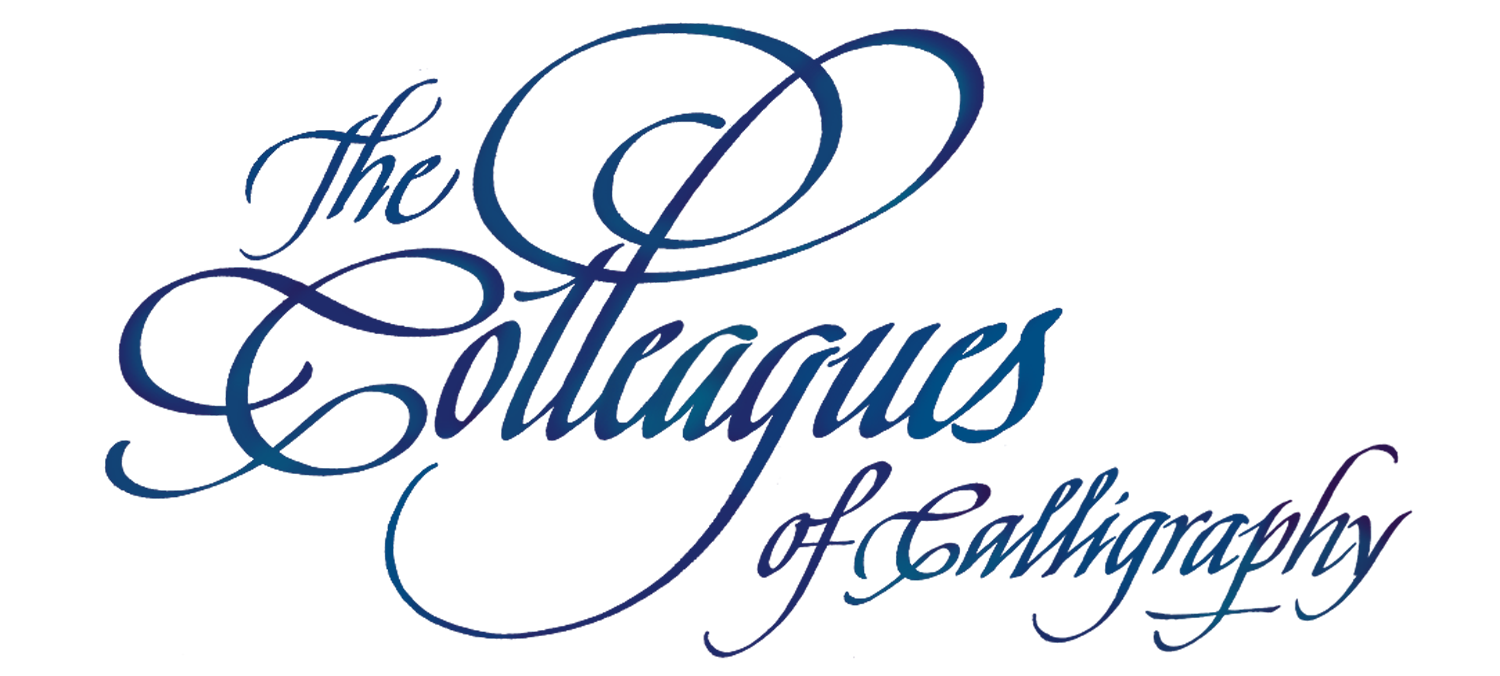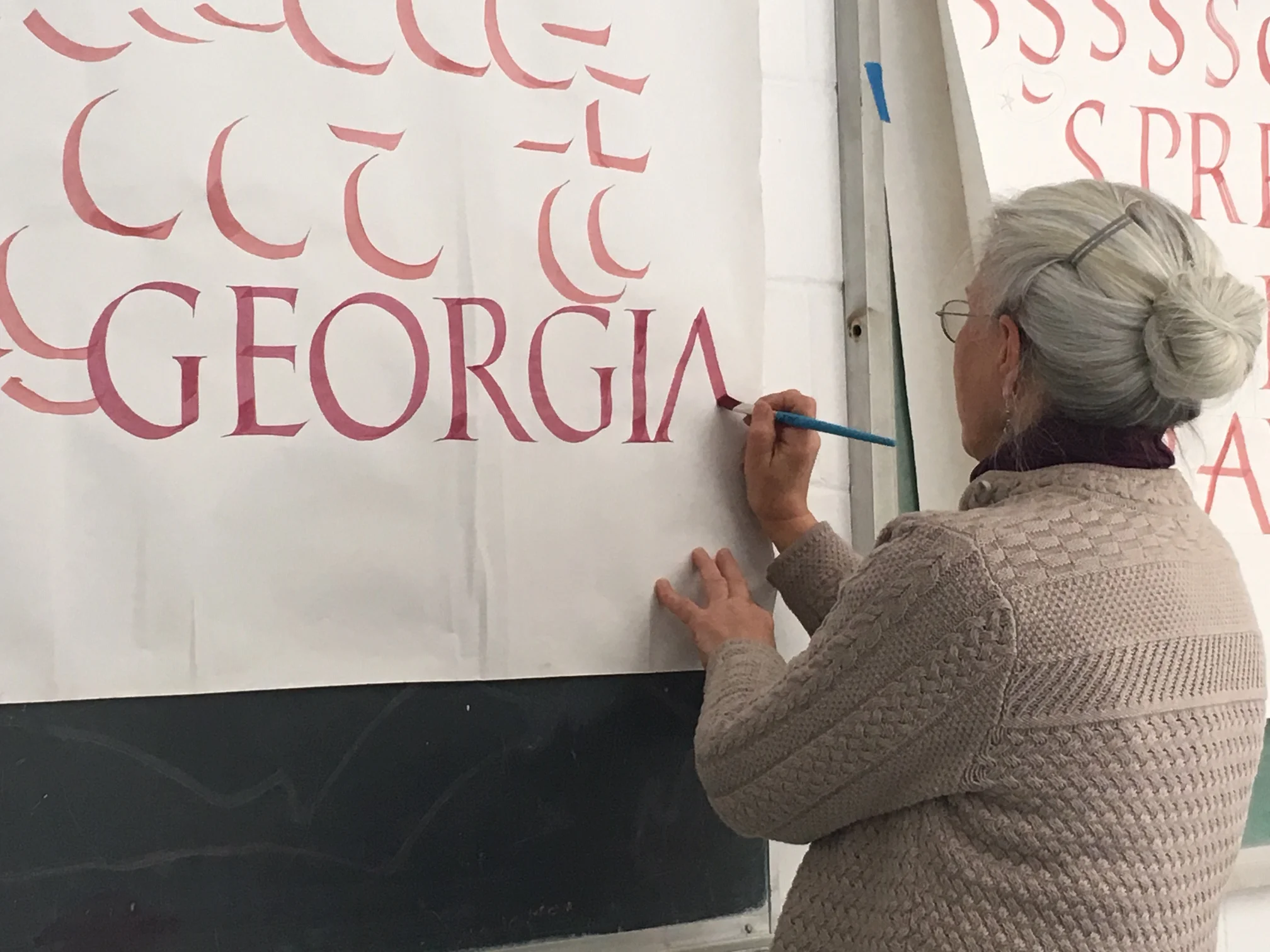Janey instructing on letter spacing techniques
Roman capitals. Let’s be honest, just thinking about them makes some of us break out into a cold sweat. So many angles, so many points, scary-straight lines, and the spacing challenges! Throw brushwork into the mix, and many of us who attended Janey Westin’s weekend workshop, “Strength in Letterforms — Using the Chisel-Edged Brush,” began class a little out of our element.
Thank goodness we had Janey there to guide us. Incredibly, Janey brought an actual-sized tracing of the Trajan Column epigraph her husband completed from casts of the carving. She began class having us gather around the inscription so we could see, up close and personal, how the Roman letterforms were crafted. Janey took care to acknowledge the astounding beauty and skill before us — but also pointed out areas where the carver was inconsistent or flawed. It was tremendous fun to go through the letters as a group and find “good M’s,” compare point heights of the A’s, or analyze serif lengths. Janey emphasized that this was what made the letters special: that they were human and handmade — despite their apparent “perfection,” no two letters were exactly alike. During the course of the program, whenever we needed a jolt of inspiration or a good example, Janey encouraged us to “go look at the Trajans!”
The workshop was further rooted in Roman letterform alphabets developed by Fr. Edward M. Catich and L.C. Evetts, and Janey provided us with printouts from Catich’s The Origin of the Serif and Evetts’ Roman Lettering. These were invaluable reference points as we made our way through the alphabet and needed a nudge in the right direction (especially on C’s pesky lower stroke!). We also had a print of Julian Waters’ Roman capitals on hand for a slightly different example of the form.
The brush added another element of challenge to a room full of people all a bit more comfortable with pen nibs. Janey assigned the brush for this course (a 3/4” Princeton Select — flat wash, short handle) so that we were all working with the same tool. We used gouache with high water content to better see how our strokes came together when creating the letters. Janey then helped us establish effective Roman brush technique by instructing us to keep our brushes upright and properly paletted, and gave us good advice for pulling clean, strong letter lines with minimal wobble.
Janey Westin, outside her studio, with the work-in-progress “Bear and Bunny” sculpture for the Edina Library.
Janey would start us on two or three related letterforms, demonstrating the technique in front the class, showing us the special characteristics and potential trouble spots. We learned that Romans require lots of forward-thinking so that serifs line up right, points are pointy, angles fall accurately, and curves round gracefully. Janey then coached us individually, making sure each student was grasping the concepts. Although she claimed she wouldn’t make it through the alphabet in two days, make it she did! And she was also able to provide us with beautiful examples of Roman-style Arabic numbers, ampersands, and ligatures.
Some non-Trajan fun was had as we played around with gothic letters and uncials to give ourselves a little break in the action. Janey demonstrated lettering an exquisite French gothic hand she found years ago in library archives. We were also treated to a book give-away from Janey’s own collection. These were no ordinary door prizes — the drawing included a hardcover copy of The Origin of the Serif signed by Catich himself, as well as a limited edition two-book set containing superb Catich letterform plates.
Janey brought such tremendous humanity to this intimidating form. Although her technique was astonishingly precise, she gave us full permission to make mistakes and try new things. Calligraphy can sometimes be a rigid little art, and I think many of us get hung up on perfection. Janey was a delightful antidote to this line of thinking, proving that you can be a craftsperson of the highest caliber while maintaining humor, flexibility, and kindness. She encouraged us to modify tools if we needed to, flip our paper around for a new perspective, and approach the letters the way that worked best for us. (We even learned that serifs are sometimes best executed if you make silly sound effects!) Janey was all skill and no pretension.
Along with the brush-lettering lessons, Janey also gave us fascinating background information about the Roman alphabet, as well as insight into how she, as a carver, approaches the letterforms. Overall, it was a fantastically rich hybrid program of lettering, painting, stonework, art history, graphic design, and storytelling.
There’s an adage in skiing. Basically, they say that by the time you’ve finally gotten the hang of it, it’s time to leave the slopes! This was exactly how I felt Sunday afternoon. As my lines became more confident and my letterforms started to achieve a smidgen of grace, alas, it was time to pack it up. Who knew that two days could fly by so quickly? I’m guessing I wasn’t the only attendee who found themselves unexpectedly in love with brush-lettered Romans by the end of the weekend. Thank you, Janey, for a truly unforgettable experience!














